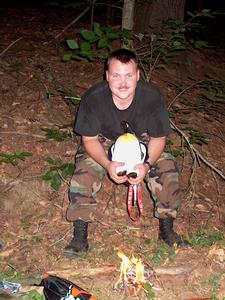9 August, 2001
Safety in the Field
This week I am receiving massive amounts of information. Each new
presenter makes me want to spend days learning more... it's all just
so interesting!
Below are some pictures of my Antarctic buddy in Field Safety class.
He is pictured with Duwain Aamodt and Todd Erickson, United States
Air Force Safety Instructors from Fairchild Air Force Base in
Washington. These instructors taught us how to survive in difficult
weather conditions. I certainly DO NOT expect to need to use any of
this information in Antarctica, but it is always important to plan
for unexpected situations. We can all benefit from this information
because you never know when you might need to use survival skills.
This information is helpful for hikers, campers, and anyone who might
find themselves in a severe weather situation.
We learned the FIVE BASICS OF SURVIVAL and to be prepare by carrying
a survival kit containing such things as wire, compass, flashlight,
bandages, and more.
1. Personal Protection - In a cold weather environment this is critical!
A. Put on appropriate clothing. Ex. You lose a great deal of
heat from your head, so wear a warm hat.
B. Find/Build a shelter - out of branches, moss, snow, tree
stumps, or anything else that will help protect you >from wind, cold
temperatures, and precipitation.
C. Fire - Know how to start a fire, even with wet or green wood.
Use alternative sources of fuel.
D. Equipment - sleeping bag, raft, survival kit, etc.
2. Sustenance - You will need nourishment!
A. Water - Because of the energy loss to the body when snow is
melted in your mouth, it is more beneficial to melt it before
consuming it.
B. Food - Learn what types of plants and animals you can obtain
to sustain you.
3. Health
A. Physical Health - the better your physical condition, the
better your chances for survival.
B. Mental Health - stay calm and focused
4. Signaling/Communication/Recovery
Use such signaling devices as a mirror, knife blade, flare gun,
fire, strobe light, radio, etc.
5. Travel - Be prepared and know that you may have to move to find help.
Some of this training is not helpful if you are traveling to
Antarctica. For example, there are no plants in the middle of
Antarctica to eat. Also, dry valley regions and areas away from the
ocean do not have any animals you could eat. (Dry valleys only have
microscopic nematode worms and other microscopic organisms. But I
shouldn't really say "only" because it is amazing to me that ANYTHING
exists in these very remote and severe weather regions.) So I will
probably receive a different type of safety training when I go to
Antarctica called "Happy Camper School". Everyone who travels
through McMurdo, a USA station, must attend this school. If you are
not familiar with Antarctica and the various research stations, try
locating McMurdo in an atlas. Also look for Amundsen-Scott station
which is located at the geographic South Pole.
Saturday, August 11th is our last day of orientation. We will have
some time to take pictures, so I will post photos of the Arctic and
Antarctic teachers for 2002/2003 on that day.

1. We're getting ready to head off to the woods of New Hampshire for = some field safety training.

2. Learning the best ways to start a fire with wet and/or green wood. = Paper birch bark and shavings from branches are helpful.
Contact the TEA in the field at
.
If you cannot connect through your browser, copy the
TEA's e-mail address in the "To:" line of
your favorite e-mail package.
|
